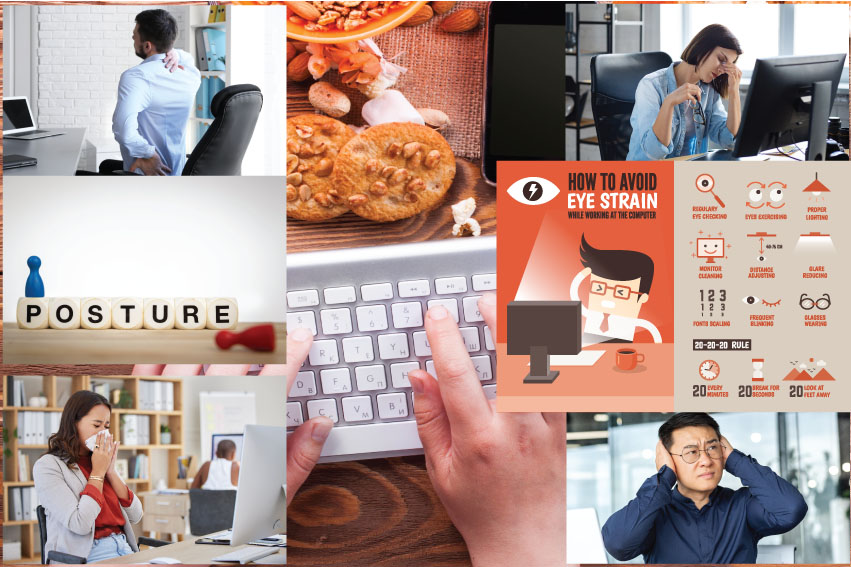
When your employees dedicate one-third (or more) of their day to work, whether it's sitting in front of a computer, working on a production line, or at a construction site, they may be exposed to health risks. Even seemingly innocuous work situations, such as sitting at a desk, can lead to serious chronic health issues over time.
While each job and industry has unique circumstances, there are common health risks that every employer should be aware of.
Unexpected Hazards in an Office Workplace
Here are five common office health and safety hazards, along with tips on how to prevent them and keep your employees happy, healthy, and engaged.
Neck and Lower Back Pain
According to a survey conducted on 2,000 professionals in the UK, a significant majority of 78% reported experiencing back pain, knee pain, and repetitive strain injuries related to their job. Additionally, almost half of the respondents have suffered from lower back pain, while one in five have experienced tingling or numbness in their fingers or hands.
Remaining upright for extended durations, hunching over a computer, or sitting with poor posture (such as over-arching the lower back) can all contribute to discomfort in the neck and lower back.
In addition to maintaining good posture while sitting at your desk, incorporating regular exercise into your routine, including exercises that strengthen your abdominal muscles, can help alleviate pressure on your lower back.
Contagious Illnesses
When considering the dirtiest jobs in the world, office work typically doesn't come to mind for most people. However, in terms of bacteria and germs, the office can be up to 400 times more contaminated than a toilet.
The prevailing workplace illnesses often comprise of the common cold, stomach flu, and strep throat. While some individuals may be able to continue working despite these illnesses, people with weaker immune systems may find themselves debilitated.
If you regularly eat your lunch at your desk, it's important to have hand sanitiser and antibacterial wipes on hand to clean your work surface daily. Keeping your desk clean not only minimises your exposure to harmful germs but also helps to declutter your workspace. This can also protect you from germs that may be dispersed into the air by co-workers who cough or sneeze nearby.
It's also important to encourage employees to stay home if they show any signs of illness. Many viruses can be transmitted before symptoms fully manifest.
Obesity
While not a new problem, the issue of obesity in workplaces worldwide is worsening due to factors such as reduced physical activity, heightened stress levels, and the growing availability of unhealthy junk food.
A well-designed wellness plan can play a pivotal role in promoting health and enhancing employee engagement in the workplace. This includes creating a healthy environment with nourishing snacks available in the kitchen, as well as providing a comfortable break room. Encouraging walk-and-talk meetings and physical team activities can help break up the day and keep the mind and body stimulated.
Eye Strain
With the increasing prevalence of screens dominating our daily activities, our eyes are increasingly experiencing the negative effects of prolonged screen time. This phenomenon is known as computer vision syndrome (CVS), which is caused by repetitive eye movements. The flicker and glare from screens can be particularly straining on the eyes compared to reading from a paper, resulting in issues such as blurred vision, eye irritation, and headaches.
Studies have shown that the ideal position for your computer monitor is slightly below eye level, positioned about 20 to 28 inches away from your face. Minimising glare on the screen is also important for eye health. Additionally, giving your eyes regular breaks every 20 minutes can be beneficial. You can take a moment to look at a photograph on your desk, gaze out the window, or simply close your eyes for a brief rest.
Noise Stress
According to the 'Noise and Wellbeing at Work' survey, 44% of office workers in the UK reported that workplace noise had a negative impact on their overall wellbeing, with over 40% experiencing work-related stress due to noise.
Exposure to excessive noise can trigger the body's stress response, leading to chronic stress. Studies have linked workplace noise to health issues such as high blood pressure, poor sleep quality, and increased risk of heart disease.
It is crucial to take measures to prevent the negative effects of noise on employees' health and stress levels in the workplace. Ensuring a conducive noise environment for your employees is essential for their overall wellbeing.
Create a Healthy Office Environment with Label Source
Here at Label Source, we provide a wide range of office signs. These signs include health and safety signs guiding and informing your workplace on issues such as stress management and desk posture to ensure your colleagues are fully informed on how to have a healthy workplace life.